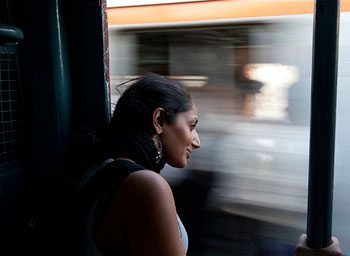By Elle Rahilly
In Around India in 80 Trains author Monisha Rajesh describes her railway travels through India, a country she came to appreciate in retrospect 20 years after her return. Touring the country entailed large distances, with Rajesh hopping aboard 80 separate trains.
Throughout the novel, Rajesh challenges herself with a fixed determination to experience every drop of the country and culture first-hand. In doing so, the author compares what she witnesses upon her return to how she once remembered life in India.
The following excerpt describes an example of the hardships and happenings Rajesh experienced during her travels. While the successful and breath-taking journey across India may be envied by travelers worldwide, it required much effort and patience to see so many every aspects of the country. Rajesh attributes the extreme crowdedness of railways in India to their popularity, like many things in crowded India.
Monisha Rajesh was raised and educated in England. The author holds a strong passion for journalism, contributing to The New York Times, Time Magazine, and The Week magazine. Around India in 80 Days is Monisha Rajesh’s first novel.
Excerpt
Hindus Only Allowed
Traveling on 80 trains was a tall order, but the number was set to rise in the next week on the Great South India Temple Tour through Madurai, Trichy, Thanjavur, and Nagapattinam, ending in Chennai. Each city was relatively close to the next and the stretch would include a number of unreserved passenger trains. As the Nagercoil Express slipped into Madurai at midnight, it marked number 11.
Madurai’s Hotel Chentoor had been booked on account of the guidebook’s description of ‘spic-and-span-rooms’, which were so filthy that the sheets looked as though someone had died in them. A patch of greasy handprints slapped on the wall—just above the pillow—suggested that the room had, however, witnessed plenty of live activity. According to the same book, the hotel also laid claim to ‘what surely must be the dimmest lit bar in India’.
That much was true. It was a perfect hideout for meetings between hookers and drug dealers, or, more fitting for Madurai, young lovers cowering in corners. The bar was so dark that it was impossible to see whether anyone was in there and it required much blinking and grappling to find a table or a waiter.

Once we adjusted to the darkness and ordered drinks, Sai Baba became the topic of conversation. Not Shirdi Sai Baba, the slight man with a white beard and headscarf often seen holding one foot across his knee, but Sathya Sai Baba, more commonly known as ‘the one with the ’fro’.
Just before the age of 14, he had declared to his parents that he had come to this world with a mission to re-establish the rhythm of righteousness in the world and to motivate love for God and had since earned a mass following that included Prime Minister Manmohan Singh, Sonia Gandhi and Sachin Tendulkar.
He was famed for performing miracles that ranged from coughing up what looked like golden Easter eggs into hankies to curing illnesses and conjuring up sacred ash, which he then sprinkled into his devotees’ outstretched hands. His ashrams were established in over 100 countries, though his image was heavily tainted with allegations of sexual abuse and fakery.
Passepartout looked around and smirked. ‘They have photos of him everywhere. It’s crazy.’
It was true. Most hotels, restaurants, and shops displayed his photo with a stick of incense crumbling in front. Friends had sat in his audiences and were convinced that he was as much a miracle worker as a magician at a six-year-old’s birthday party. Passepartout was on a roll.
‘He should be exposed! People like that should be brought down and put away for exploiting the poor.’
‘But at least he funds hospitals and schools.’
‘These people make the poor spend money on small pictures and trinkets that do nothing!’ His voice was rising and a furrow began to crawl down his forehead.
‘If keeping a photo of somebody gives them a sense of protection and comfort, and that’s all they have, who are you to criticize their choice?’
‘Carrying pictures of people who aren’t real and placing faith in them is fucking stupid!’
My cheeks prickled. In the cloth purse, I had bought at Dilli Haat was a palm-sized picture of Shirdi Sai Baba that my dad had given me the day before I left England. An amusing chat had morphed into an ugly exchange and I was keen to end the discussion over what was essentially a personal choice. I picked up a handful of chilli peanuts as our drinks arrived.
‘Anyway, can we please stop talking about this?’
‘It’s dis-gust-ing!’ he annunciated, as though I had learning difficulties.
‘Why do you care so much?’ I asked. ‘It’s really none of your business what other people choose to do with their lives. I’ve already asked nicely if we could change the topic.’
‘He’s a FUCKING FAKE!’ he spat, showing no sign of relenting.
I briefly mulled over the face gurning across the table, then took a small sip of my gin and tonic.
‘Talk to me like that again and you’re on your own.’
Author Monisha Rajesh.

I picked up my bag and walked out, leaving Passepartout, his beer and his anger to stew together. It was nearing 4 pm and the Meenakshi temple would soon be open to afternoon visitors, so I made my way there alone. It was not that I disagreed with his sentiment, but spouting obscenities in the middle of a bar more reminiscent of a dungeon was hardly the appropriate warm-up to visiting a temple.
Winding through a labyrinth of back streets, I spotted the first of the Meenakshi temple’s gopurams rising above the entrance to the temple town. It was a gaudy, wedge-shaped monumental tower, decorated with radioactive paint and covered with rows of gods, goddesses and demons. They had eyes like Chihuahuas being squeezed at the neck and a confusing mix of beards and breasts. Winged lizards glared outwards, their tongues hanging out next to figures that looked like a mixture between Chinese dragons and angry housewives.
Inside was beautiful. Feminine figures frozen in motion gazed outwards, their sharp nostrils breathing in a combination of camphor and marigolds. The walls were cool to touch and the ground warm from hundreds of pairs of feet padding through. Worshippers had thronged for the evening puja and hurried past carrying ladoos, garlands and restless children.
In the heart of the temple, butter-balls, rolled and sold outside, were being thrown at the statue of Meenakshi and her consort and a group had gathered before Parvathi, the temple elephant. If visitors bowed before her, she placed a blessing on their head with her trunk, then swung the hairy tip down to take a coin from their hand, dropping it into the lap of her owner who sat behind. It was a smart, entrepreneurial move, marrying charm and religious servitude for material gain, but ultimately being tapped on the head by a smiley elephant was a rare occurrence and childish thrill.
Rajesh hopping trains.

One afternoon, while being walked to the temple, Parvathi had been scared by a couple of stray dogs and charged into a restaurant, much to the horror of the diners but to the delight of the owner. Overjoyed that the elephant had blessed his establishment, he rewarded the tear away with 100 idlis and a handful of bananas. Parvathi was a proper little Indian with the right level of cunning to survive.
A short distance away, a man using opposite hands to grip each of his earlobes with two fingers began bobbing up and down in penance. His son was pulling at his pocket, asking for a coin for Parvathi. He ignored him and the child gave one last, fatal tug. He turned, slapped his son on the back of the head and went back to gripping his earlobes.
This behavior was not uncommon. During my Madras days, I would often dangle my feet through the gaps of the balcony and watch the Brahmin at the house next door doing his daily puja. Every morning without fail, he would appear, freshly bathed and powdered, then sneak across the road to snap three heads off the bougainvillea tree that belonged to two dancers, scuttling back to place them on his shrine.
‘Shameless fellow, as if God can’t see you,’ my mum would mutter.
Fed up and feeling cynical, I wandered out of the temple and found cynicism personified lurking with his camera. After a stiff exchange, Passepartout and I made our way back through the streets to catch train number 12, the Nagercoil-Chennai Express to Trichy, where the Sri Rangam temple awaited our arrival.
Buy this book on Amazon: Around India in 80 Trains

Elle Rahilly is a former editorial assistant for GoNOMAD.com and now works in fashion in New York City.
- These 9 U.S. National Parks Require Reservations in 2024 - April 17, 2024
- Take a Hike in Olympic National Park - April 17, 2024
- The Wild Mississippi: 2340 Miles Across Ten States - April 8, 2024






